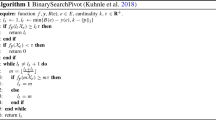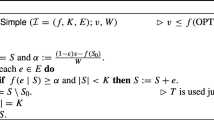Abstract
In this paper, we study the problem of maximizing the Difference of two Submodular (DS) functions in the streaming model, where elements in the ground set arrive one at a time in an arbitrary order. We present one-pass streaming algorithms for both the unconstrained and cardinality-constrained problems. Our analysis shows that the algorithms we propose are able to produce solutions with provable approximation guarantees. To the best of our knowledge, this is the first theoretical guarantee for the DS maximization problem in the streaming model. In addition, we study the function maximization problem under a cardinality constraint, where the underlying objective function is a \(\gamma \)-weakly DR-submodular function, in the streaming setting. We propose a one-pass streaming algorithm, which achieves an approximation ratio of \(\gamma /(1 + \gamma ) - \epsilon \). Since the sum of suBmodular and suPermodular (BP) functions can be regarded as a \((1 - \kappa ^g)\)-weakly DR-submodular function, we obtain a \(( (1 - \kappa ^g)/(2 - \kappa ^g) - \epsilon )\)-approximation for the cardinality-constrained BP maximization, where \(\kappa ^g\) is the curvature of the corresponding supermodular function. Our results improve the previous best approximation bounds.
Similar content being viewed by others
Notes
Set function f is called monotone if \(f(A) \le f(B)\) for every \(A \subseteq B \subseteq \varOmega \).
For instance, the approximation bound usually takes the form of \(1-e^{-\gamma }\), where \(\gamma \) is the parameter defined to measure the distance between a nonsubmodular function and a submodular one.
A monotone set function \(f :2^\varOmega \rightarrow \mathbb {R}_{\ge 0} \) is called \(\gamma \)-weakly DR-submodular if \(f(e|A) \ge \gamma \cdot f(e|B)\) holds for every \(A \subseteq B \subset \varOmega \) and \(e \in \varOmega \setminus B\).
Throughout this paper, we denote set \(\{1,2,\ldots ,r\}\) by [r] for every positive integer r.
References
Badanidiyuru, A., Mirzasoleiman, B., Karbasi, A., Krause, A.: Streaming submodular maximization: massive data summarization on the fly. In: Proceedings of the 20th ACM SIGKDD International Conference on Knowledge Discovery and Data Mining, pp. 671–680 (2014)
Bai, W., Bilmes, J.: Greed is still good: maximizing monotone submodular+ supermodular (bp) functions. In: International Conference on Machine Learning, pp. 304–313. PMLR (2018)
Bai, W., Iyer, R., Wei, K., Bilmes, J.: Algorithms for optimizing the ratio of submodular functions. In: International Conference on Machine Learning, pp. 2751–2759. PMLR (2016)
Bian, A.A., Buhmann, J.M., Krause, A., Tschiatschek, S.: Guarantees for greedy maximization of non-submodular functions with applications. In: International Conference on Machine Learning, pp. 498–507. PMLR, (2017)
Bogunovic, I., Zhao, J., Cevher, V.: Robust maximization of non-submodular objectives. In: International Conference on Artificial Intelligence and Statistics, pp. 890–899. PMLR (2018)
Buchbinder, N., Feldman, Moran, Schwartz, R.: Online submodular maximization with preemption. ACM Trans. Algorithms (TALG) 15(3), 1–31 (2019)
Byrnes, Kevin M.: A tight analysis of the submodular-supermodular procedure. Discret. Appl. Math. 186, 275–282 (2015)
Calinescu, G., Chekuri, Chandra, Pal, M., Vondrák, J.: Maximizing a monotone submodular function subject to a matroid constraint. SIAM J. Comput. 40(6), 1740–1766 (2011)
Chen, L., Feldman, M., Karbasi, A.: Weakly submodular maximization beyond cardinality constraints: does randomization help greedy? In: International Conference on Machine Learning, pp. 804–813. PMLR (2018)
Conforti, M., Cornuéjols, Gérard.: Submodular set functions, matroids and the greedy algorithm: tight worst-case bounds and some generalizations of the rado-edmonds theorem. Discret. Appl. Math. 7(3), 251–274 (1984)
Das, A., Kempe, D.: Submodular meets spectral: greedy algorithms for subset selection, sparse approximation and dictionary selection. In: Proceedings of the 28th International Conference on International Conference on Machine Learning, pp. 1057–1064 (2011)
Das, A., Kempe, David: Approximate submodularity and its applications: Subset selection, sparse approximation and dictionary selection. J. Mach. Learn. Res. 19(1), 74–107 (2018)
El Halabi, M., Bach, F., Cevher, V.: Combinatorial penalties: which structures are preserved by convex relaxations? In: International Conference on Artificial Intelligence and Statistics, pp. 1551–1560. PMLR (2018)
Elenberg, E.R., Dimakis, A.G., Feldman, M., Karbasi, A.: Streaming weak submodularity: interpreting neural networks on the fly. In: Proceedings of the 31st International Conference on Neural Information Processing Systems, pp. 4047–4057 (2017)
Feige, U., Immorlica, N., Mirrokni, V.S., Nazerzadeh, H.: Pass approximation: a framework for analyzing and designing heuristics. Algorithmica 66(2), 450–478 (2013)
Feldman, Moran: Guess free maximization of submodular and linear sums. Algorithmica 83(3), 853–878 (2021)
Gatmiry, K., Gomez-Rodriguez, M.: Non-submodular function maximization subject to a matroid constraint, with applications. arXiv preprint arXiv:1811.07863, (2018)
Gong, S., Nong, Q., Sun, T., Fang, Q., Dingzhu, Du., Shao, Xiaoyu: Maximize a monotone function with a generic submodularity ratio. Theor. Comput. Sci. 853, 16–24 (2021)
Harshaw, C., Feldman, M., Ward, J., Karbasi, A.: Submodular maximization beyond non-negativity: guarantees, fast algorithms, and applications. In: International Conference on Machine Learning, pp. 2634–2643. PMLR (2019)
Iyer, R., Bilmes, J.: Algorithms for approximate minimization of the difference between submodular functions, with applications. In: Proceedings of the Twenty-Eighth Conference on Uncertainty in Artificial Intelligence, pp. 407–417 (2012)
Tianyuan Jin, Y., Yang, Renchi Yang, Shi, J., Huang, K., Xiao, X.: Unconstrained submodular maximization with modular costs: tight approximation and application to profit maximization. Proc. VLDB Endow. 14(10), 1756–1768 (2021)
Kazemi, E., Mitrovic, M., Zadimoghaddam, M., Lattanzi, S., Karbasi, A.: Submodular streaming in all its glory: tight approximation, minimum memory and low adaptive complexity. In: International Conference on Machine Learning, pp. 3311–3320. PMLR (2019)
Kazemi, E., Minaee, S., Feldman, M., Karbasi, A.: Regularized submodular maximization at scale. In: International Conference on Machine Learning, pp. 5356–5366. PMLR (2021)
Kempe, D., Kleinberg, J., Tardos, É.: Maximizing the spread of influence through a social network. In: Proceedings of the Ninth ACM SIGKDD International Conference on Knowledge Discovery and Data Mining, pp. 137–146 (2003)
Krause, A., Guestrin, C.: Near-optimal observation selection using submodular functions. In: AAAI. vol. 7, pp. 1650–1654 (2007)
Krause, A., Singh, Ajit, Guestrin, C.: Near-optimal sensor placements in gaussian processes: theory, efficient algorithms and empirical studies. J. Mach. Learn. Res. 9(Feb), 235–284 (2008)
Lehmann, B., Lehmann, Daniel, Nisan, N.: Combinatorial auctions with decreasing marginal utilities. Games Econ. Behav. 55(2), 270–296 (2006)
Liu, Z., Chen, L., Chang, H., Donglei, D., Zhang, X.: Online algorithms for bp functions maximization. Theor. Comput. Sci. 858, 114–121 (2021)
Narasimhan, M., Bilmes, J.A.: A submodular-supermodular procedure with applications to discriminative structure learning. arXiv preprint arXiv:1207.1404, (2012)
Nemhauser, G.L., Wolsey, Laurence A., Fisher, M.L.: An analysis of approximations for maximizing submodular set functions-i. Math. Program. 14(1), 265–294 (1978)
Nikolakaki, S.M., Ene, A., Terzi, E.: An efficient framework for balancing submodularity and cost. In: Proceedings of the 27th ACM SIGKDD Conference on Knowledge Discovery & Data Mining, pp. 1256–1266 (2021)
Norouzi-Fard, A., Tarnawski, J., Mitrovic, S., Zandieh, A., Mousavifar, A., Svensson, O.: Beyond 1/2-approximation for submodular maximization on massive data streams. In: International Conference on Machine Learning, pp. 3829–3838. PMLR (2018)
Perrault, P., Healey, J., Wen, Z., Valko, M.: On the approximation relationship between optimizing ratio of submodular (rs) and difference of submodular (ds) functions. arXiv preprint arXiv:2101.01631, (2021)
Sviridenko, M., Vondrák, Jan, Ward, J.: Optimal approximation for submodular and supermodular optimization with bounded curvature. Math. Oper. Res. 42(4), 1197–1218 (2017)
Vondrák, J.: Submodularity and curvature: the optimal algorithm (combinatorial optimization and discrete algorithms). RIMS Kokyuroku Bessatsu 23, 253–266 (2010)
Wang, Y., Dachuan, Xu., Wang, Y., Zhang, D.: Non-submodular maximization on massive data streams. J. Glob. Optim. 76(4), 729–743 (2020)
Yang, F., He, Kai, Yang, L., Hongxia, D., Yang, J., Yang, Bo., Sun, Liang: Learning interpretable decision rule sets: a submodular optimization approach. Adv. Neural Inf. Process. Syst. 34, 27890–27902 (2021)
Yuille, A.L., Rangarajan, A.: The concave-convex procedure. Neural Comput. 15(4), 915–936 (2003)
Acknowledgements
We thank the Associate Editor and two anonymous reviewers for their insightful comments. This research is supported by the National Natural Science Foundation of China under Grant Numbers 11991022 and 12071459 and the Fundamental Research Funds for the Central Universities under Grant Number E1E40107X2.
Author information
Authors and Affiliations
Corresponding author
Additional information
Publisher's Note
Springer Nature remains neutral with regard to jurisdictional claims in published maps and institutional affiliations.
Rights and permissions
Springer Nature or its licensor (e.g. a society or other partner) holds exclusive rights to this article under a publishing agreement with the author(s) or other rightsholder(s); author self-archiving of the accepted manuscript version of this article is solely governed by the terms of such publishing agreement and applicable law.
About this article
Cite this article
Lu, C., Yang, W. & Gao, S. Streaming algorithms for maximizing the difference of submodular functions and the sum of submodular and supermodular functions. Optim Lett 17, 1643–1667 (2023). https://doi.org/10.1007/s11590-023-01979-w
Received:
Accepted:
Published:
Issue Date:
DOI: https://doi.org/10.1007/s11590-023-01979-w




